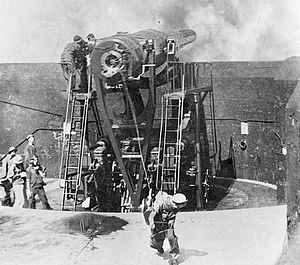| 12-inch gun M1895 | |
|---|---|
 12-inch M1895 coastal defense gun being fired by lanyard | |
| Type | Coastal artillery |
| Place of origin | United States |
| Service history | |
| In service | 1895–1945 |
| Used by | United States Army |
| Wars | World War I, World War II |
| Production history | |
| Designer | Watervliet Arsenal |
| Designed | 1888 |
| Manufacturer | Watervliet Arsenal, Bethlehem Steel, possibly others |
| Variants | M1888, M1895, M1900 |
| Specifications | |
| Mass | 115,000 pounds (52,163 kilograms) (M1895) |
| Length | 442.56 inches (11.241 meters) |
| Barrel length | 35 calibers (442.56 inches; 11.241 meters) |
| Shell | separate loading, 975 pounds (442 kg) AP, 1,070 pounds (490 kg) AP shot & shell[1] |
| Caliber | 12 in (305 mm) |
| Breech | Welin breech block |
| Carriage | M1891 gun lift, M1892 or M1897 barbette, M1896, M1897 or M1901 disappearing, M1917 long-range barbette from 1920[2] |
| Traverse | disappearing: 170° (varied with emplacement), long-range M1917 barbette: 360° (145° casemated), railway: 10° |
| Muzzle velocity | 2,250 feet per second (690 m/s)[3] |
| Maximum firing range | disappearing: 18,400 yards (16,800 m), long-range M1917 barbette: 30,100 yards (27,500 m), railway: 30,100 yards (27,500 m)[1] |
| Feed system | hand |
The 12-inch coastal defense gun M1895 (305 mm) and its variants the M1888 and M1900 were large coastal artillery pieces installed to defend major American seaports between 1895 and 1945. For most of their history they were operated by the United States Army Coast Artillery Corps. Most were installed on disappearing carriages, with early installations on low-angle barbette mountings. From 1919, 19 long-range two-gun batteries were built using the M1895 on an M1917 long-range barbette carriage. Almost all of the weapons not in the Philippines were scrapped during and after World War II.
- ^ a b Berhow, p. 61
- ^ Berhow, pp. 130–155
- ^ Description of 8, 10, 12, 14, and 16-inch Seacoast Guns, p. 32